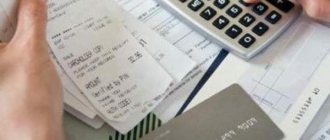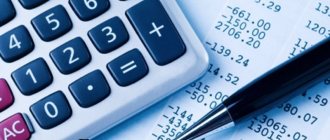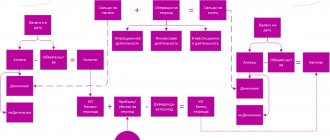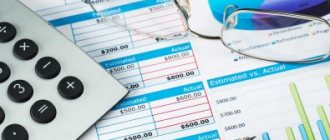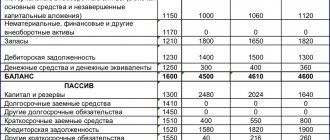It is necessary to generate a financial performance report (financial performance report) for 2021 on an updated form. The latest adjustments to the report form approved by Order of the Ministry of Finance of the Russian Federation No. 66n dated July 2, 2010 were made by Order No. 61n dated April 19, 2019. They are caused by bringing the RAS rules for accounting for tax liabilities in accordance with the requirements of IFRS, as well as changes in PBU 18/02 (Order of the Ministry of Finance No. 236n dated November 20, 2018). Let's talk about the adjustments to PBU 18/02 and what impact they had on the calculation of indicators in the general financial market.
Line 2120 “Cost of sales”
This line reflects information on expenses for ordinary activities that formed the cost of goods sold, products, work performed and services rendered (clauses 9, 21 of PBU 10/99).
What expenses form the cost
sold goods, products, works, services
The cost of goods, works, and services sold includes the following expenses for ordinary activities (clauses 4, 5, 9 of PBU 10/99, clauses 11, 22, paragraph 3 of clause 23 of PBU 2/2008):
— costs associated with the manufacture of products;
— expenses associated with the purchase of goods;
— costs associated with the performance of work;
— expenses associated with the provision of services;
— expenses associated with the provision of property for rent (in organizations whose subject of activity is the provision of their assets for rent);
— costs associated with granting rights to use the results of intellectual activity (in organizations whose subject of activity is the provision of such rights for a fee);
— expenses associated with participation in the authorized capitals of other organizations (in organizations whose subject of activity is participation in the authorized capitals of other organizations);
— amounts of deviations, claims, incentive payments recognized as part of revenue under construction contracts in previous reporting periods, the receipt of which was in doubt (expected losses);
— other expenses depending on their nature, conditions of implementation and areas of activity of the organization.
For organizations performing work under construction contracts, direct costs under the contract (expenses for ordinary activities) can be reduced by the organization’s income not directly related to the execution of the contract, received during the execution of other contracts (paragraph 3 of clause 12 of PBU 2/2008 ). For example:
— on income from the sale of materials and structures excessively written off for production;
- for rent for construction equipment that is temporarily not used by the organization itself for the execution of a construction contract.
The cost of goods, products, works, services sold is written off from accounts 20 “Main production”, 23 “Auxiliary production”, 29 “Service production and facilities”, 41 “Goods”, 43 “Finished products”, 40 “Output of products, works, services" and others to the debit of account 90 "Sales", subaccount 90-2 "Cost of sales" (Instructions for using the Chart of Accounts).
Note that administrative expenses accounted for on account 26 “General business expenses”, in accordance with the accounting policy of the organization (clause 9, 20 PBU 10/99, Instructions for using the Chart of Accounts):
1) may be included in the cost of products, works, services (debited from account 26 to accounts 20, 23, 29);
2) as conditionally constant, they can be attributed directly to the cost of sales of the reporting period in which they arose (written off from account 26 to the debit of account 90, subaccount 90-2).
Attention!
General business expenses of construction organizations can be included in the cost of work under construction contracts only if their reimbursement by the customer is provided for (clause 14 of PBU 2/2008).
In the first case, these expenses form the indicator on line 2120 “Cost of sales”, and in the second - they are shown on line 2220 “Administrative expenses” of the Income Statement.
The rules for recognizing expenses in the Statement of Financial Results are defined in paragraphs 18, 19 of PBU 10/99 and paragraphs 16, 23 of PBU 2/2008. In particular:
— expenses are recognized taking into account their connection with revenues (for example, the cost of performing work is recognized simultaneously with the recognition of revenue from their sale as income);
— if expenses determine the receipt of income over several reporting periods and the relationship between income and expenses cannot be clearly defined or is determined indirectly, then they are recognized in the Statement of Financial Results by reasonably distributing them between reporting periods;
- if an organization that is a small business entity, with the exception of issuers of publicly placed securities, revenue from the sale of products and goods is recognized not as the rights of ownership, use and disposal for the delivered products or goods sold are transferred, but after receipt of payment, then expenses are recognized after debt repayment.
Features of calculating the cost of goods, products, works, services are established by industry methodological instructions, recommendations, guidelines (clause 10 PBU 10/99, Letter of the Ministry of Finance of Russia dated April 29, 2002 N 16-00-13/03 “On the application of regulatory documents governing issues accounting for production costs and calculating the cost of products (works, services)".
ADDITIONALLY on this issue, see the subsection “Expenses for ordinary activities (by cost elements)” of the Guide to Information Security “Correspondence of invoices”.
What accounting data is used?
when filling out line 2120 “Cost of sales”
The value of the indicator of line 2120 “Cost of sales” (for the reporting period) is determined on the basis of data on the total debit turnover for the reporting period on account 90, subaccount 90-2, in correspondence with accounts 20, 23, 29, 41, 43, 40, etc. In this case, the turnover on the debit of account 90, subaccount 90-2, in correspondence with the credit of account 44, as well as in correspondence with the credit of account 26 (if any) are not taken into account (clause 23 of PBU 4/99). The resulting value of the cost of goods, products, works, services sold is indicated in line 2120 “Cost of sales” in parentheses.
Attention!
If types of income are identified in the Financial Results Report, each of which individually constitutes five or more percent of the organization’s total income for the reporting year, additional lines are added to line 2120 “Cost of sales”, which indicate expenses corresponding to the types identified by the organization income (clause 21.1 PBU 10/99).
If, in accordance with the accounting policy of the organization, management expenses are written off as semi-fixed expenses to the debit of account 90, subaccount 90-2.
The indicator in line 2120 “Cost of sales” (for the same reporting period of the previous year) is transferred from the Financial Results Report for the same reporting period of the previous year.
Example of filling line 2120
"Cost of sales"
EXAMPLE 6.2
Indicators for subaccount 90-2 of account 90 in accounting (without taking into account the turnover on the debit of subaccount 90-2 in correspondence with the credit of accounts 44 and 26):
rub.
| Turnover for the reporting period (2013) | Sum |
| 1 | 2 |
| 1. By debit of subaccount 90-2 | 72 013 678 |
| 1.1. In the debit of subaccount 90-2, analytical account for accounting for the cost of sales of finished products | 53 214 540 |
| 1.2. On the debit of subaccount 90-2, analytical account for accounting for the cost of sales of goods | 15 220 638 |
| 1.3. On the debit of subaccount 90-2, analytical account for accounting for the cost of providing intermediary services | 1 678 500 |
| 1.4. On the debit of subaccount 90-2, analytical account for accounting for the cost of car repair work | 1 900 000 |
Fragment of the Financial Results Report for 2012
| Explanations _ | Indicator name | Code | For 2012 | For 2011 |
| 1 | 2 | 3 | 4 | 5 |
| Cost of sales | 2120 | (71 165) | (67 116) | |
| including: | ||||
| products sold | 2121 | (52 600) | (50 471) | |
| goods sold | 2122 | (15 628) | (10 352) |
Solution
The cost of goods, products, works, services sold for 2013 is (total) 72,014 thousand rubles.
For types of revenue constituting at least 5%, the cost is equal to:
products sold - 53,215 thousand rubles;
goods sold - 15,221 thousand rubles.
A fragment of the Income Statement in Example 6.2 will look like this.
| Explanations _ | Indicator name | Code | For 2013 | For 2012 |
| 1 | 2 | 3 | 4 | 5 |
| Cost of sales | 2120 | (72 014) | (71 165) | |
| including: | ||||
| products sold | 2121 | (53 215) | (52 600) | |
| goods sold | 2122 | (15 221) | (15 628) |
Balance sheet
The following information is automatically indicated in the header part of the balance sheet from the client’s registration card in the SBIS system:
- the period for which the balance sheet is prepared;
- adjustment number (if the balance is primary, then “0” is indicated);
- name of the organization and TIN;
- code according to the classifier of enterprises and organizations (OKPO);
- code of type of economic activity (OKVED2);
- code of organizational and legal form (OKOPF);
- code of ownership form (OKFS);
- the unit of measurement in which the balance sheet is compiled and its code (OKEY);
- address of the organization in accordance with the constituent documents.
The balance sheet consists of two sections: assets and liabilities. In these sections, for each line, indicators are reflected as of the reporting date, as well as at the end of the two previous years.
The balance sheet is filled in based on the balances of the accounting accounts:
| Indicator name | Line code | What is reflected | Reflection order |
| ASSETS | |||
| Tangible non-current assets | 1150 | Residual value of fixed assets | Account balance 01 – Account balance 02 (excluding depreciation of objects accounted for in account 03) + Account balance: 07, 08 (in terms of expenses for construction in progress) Account balance 03 – Account balance 02 (excluding depreciation of objects , accounted for in account 01 ) |
| Intangible, financial and other non-current assets | 1170 | Residual value of intangible assets and long-term financial investments | Account balance 04 – Account balance 05 Account balance 09 Account balance: 55, 58, 73 (in terms of long-term investments) – account balance 59 (in terms of reserves for long-term investments) |
| Reserves | 1210 | Cost of inventories | Account balance: 10, 11, 15 (except for amounts reflected on line 1170) 20, 21, 23, 28, 29, 41, 43, 44, 45, 97 – Account balance: 14, 42 + (-) Balance on account 16 (except for amounts reflected on line 1170) |
| Cash and cash equivalents | 1250 | Balance of cash and cash equivalents | Account balances: 50, 51, 52, 55 (except for amounts reflected on lines 1170 and 1240), 57 |
| Financial and other current assets | 1230 | Short-term financial investments, the amount of debt of various debtors and other current assets | Account balance: 55, 58, 73 (in terms of short-term investments) – account balance 59 (in terms of reserves for short-term investments) Account debit balance: 60, 62, 68, 69, 70, 71, 73, 75, 76 – Account balance 63 |
| BALANCE | 1600 | The cost of all property of the organization | Sum of all balance sheet asset lines (calculated automatically) |
| PASSIVE | |||
| Capital and reserves *** | 1300 | The size of the organization’s own capital (authorized, additional and reserve capital, retained earnings (loss), etc.) | Balance on accounts 80, 82, 83, 84, 99 Balance on debit of account 81 |
| Target funds *** | 1350 | Amount of entrance fees and other targeted funds | Account balance: 86 (in terms of target funds), 84 |
| Fund for real estate and especially valuable movable property and other target funds *** | 1360 | The amount of share contributions of members of the consumer cooperative, investment funds for the acquisition and (or) creation of fixed assets, the amount of special target funds | Account balance: 80, 82, 83, 84, 86 (in terms of the indivisible fund and target funds) |
| Long-term borrowed funds | 1410 | Debt on long-term (over 12 months) loans and borrowings | Account balance 67 |
| Other long-term liabilities | 1450 | Other liabilities with a maturity period of more than 12 months, not reflected in other lines of this section | Account balance: 60, 62, 68, 69, 73, 75, 76, 77, 86, 96 (in terms of long-term liabilities) |
| Short-term borrowed funds | 1510 | Debt on short-term (up to 12 months) loans and borrowings | Account balance 66 |
| Accounts payable | 1520 | Amount of short-term debt to creditors | Account credit balance: 60, 62, 68, 69, 70, 71, 73, 75, 76 |
| Other current liabilities | 1550 | Other liabilities with a maturity of up to 12 months, not reflected in other lines of this section | Account balance: 76, 86, 96, 98 (in terms of other short-term liabilities) |
| BALANCE | 1700 | Sum of all funding sources | Sum of all liability lines on the balance sheet (calculated automatically) |
* — Lines are filled in if the organization - a small business entity applies PBU 18/02.
** — Amount of loss on line 1300
indicated with a minus sign.
*** — The line “Capital and reserves” is filled in by commercial organizations. Non-profit organizations, instead of the line “Capital and reserves,” fill in the lines “Target funds” and “Fund for real estate and especially valuable movable property and other target funds.”
What form should I use to prepare the Financial Results Report?
Before you begin drawing up Form No. 2, decide which form you will use. Let us remind you that “simplified”, being small businesses, have the right to choose: fill out a full Report or an abbreviated one. Both versions of the form are given in the appendices to the order of the Ministry of Finance of Russia dated July 2, 2010 No. 66n “On forms of financial statements of organizations” (hereinafter referred to as order No. 66n).
It is logical that if you use an abbreviated form when filling out a balance sheet, you choose the same for the Financial Results Report. And vice versa. Since the balance sheet and Form No. 2 are interrelated documents, the degree of information disclosure in them should be uniform.
A report in a generally accepted form is more informative. And later in the article we will talk about which lines to fill out in this particular form (the form is contained in Appendix No. 1 to Order No. 66n). And since the simplified Report (its form is contained in Appendix No. 5 to Order No. 66n) consists of the same indicators, only enlarged, it will not be difficult for you to fill out the simplified Report if you understand the usual one.
What needs to be included in form No. 2
This form of reporting is regulated by section 5 of PBU 4/99 “Accounting statements of an organization.” Previously, it was called the “Profit and Loss Statement”, but from the annual report for 2012, according to information from the Ministry of Finance of Russia No. PZ-10/2012, the Federal Law of 06.12.2011 No. 402-FZ “On” came into force on 01.01.2013 Accounting", it received a new name. The form of the financial results statement itself has not changed much, and accountants continue to use the old name as a colloquial name.
The legislation regulates what must be reflected in the financial results report for 2021:
- the amount of revenue received during the year;
- cost of sales by organization;
- administrative and commercial expenses of the organization;
- gross profit or loss for the reporting period;
- interest received and paid;
- other income and expenses for the year;
- profit or loss from sales;
- total profit or loss before taxes;
- changes during the year in deferred tax assets and liabilities;
- net profit or loss;
- other reference information.
Where to get numerical data to fill out form No. 2
The indicators for filling out form No. 2 are not account balances at the end of the year. In most cases, the Report must include the debit turnover for a specific account (or subaccount) or the sum of turnover for several accounts that do not have a balance at the end of the year. Therefore, further we will consider each line of the Report, explaining where to get the information from. And for each line we will indicate the code established by Appendix No. 4 to Order No. 66n.
Which lines of the Report are filled in based on account data 90
Revenue (code 2110). Please note that the entire Report is completed “by shipment”. That is, you take into account the accrued amounts reflected in the accounting; the fact of payment (or non-payment) does not matter. Thus, the amount of revenue reflected in the Report will not coincide with the amount of income that you calculated at the end of the year in the Income and Expense Accounting Book. After all, the Accounting Book, on the contrary, is kept only “by payment”.
The only case when in accounting revenue is recorded not by the date of shipment, but by the fact of payment, is when you have entered into a purchase and sale agreement with a special procedure for the transfer of ownership. Based on such an agreement, goods (work, services) are considered sold only after the buyer transfers money to you. But to do this, these conditions must be clearly stated in the contract. This means that the revenue accrued in accounting has already been paid. But this is an exception to the rule, because in all other situations, revenue in accounting is recorded at the moment of transfer of ownership, regardless of monetary settlements
So, in order to fill out the “Revenue” line, you need to take the total turnover for the year on the credit of account 90 of the “Revenue” subaccount. On it, you took into account sales revenue throughout the year. Then this sub-account was “reset to zero” on December 31 when the balance sheet was reformed, but before that, revenue had been accumulating for a whole year.
Cost of sales (code 2120). This indicator includes all costs for the purchase of raw materials, goods, materials and other material resources. That is, those expenses that directly affect the formation of the cost of goods (services) sold. In the Report, you fill in data about these expenses as they are accrued in accounting; payment does not matter. That is, in the line “Cost of sales” you transfer the turnover for the year to the debit of account 90 of the subaccount “Cost of sales”. Let us remind you that during the year you took into account expenses in correspondence with the following accounts: - 20 “Main production”; — 23 “Auxiliary production”; — 29 “Service industries and farms; — 41 “Products”; — 43 “Finished products”; — 45 “Goods shipped.”
When filling out cost data, subtract commercial and administrative expenses from the debit turnover of the “Cost of Sales” subaccount. That is, turnover in correspondence with accounts 44 “Sales expenses” and 26 “General business expenses”. Such transactions are reflected in your accounting by the following entries: DEBIT 90 subaccount “Cost of sales” CREDIT 44 “Sales expenses” - commercial expenses are reflected in the cost price;
DEBIT 90 subaccount “Cost of sales” CREDIT 26 “General business expenses” - administrative expenses are reflected in the cost price.
If you fill out the abbreviated form of the Report, then you do not need to deduct anything, since the debit turnover in the “Cost of Sales” subaccount is fully reflected in the “Expenses for Ordinary Activities” indicator.
Gross profit (code 2100). This is an intermediate indicator characterizing sales income. To calculate it, subtract the cost from the amount of revenue. If you draw up a Report in a simplified form, this indicator is not included in it, since the cost price is not distinguished from the total costs of production (sales). Which also includes selling and administrative expenses.
Selling expenses (2210). In this line you include data on costs associated with the sale of products: packaging of goods, delivery, loading, advertising, etc. Such amounts during each month are accumulated in the debit of account 44 “Sales expenses”, after which they are written off in the debit of the account 90. At the end of the month, a balance on account 44 is not formed in most cases (except for transportation and procurement costs, which, according to accounting policy, can be written off in proportion to the volume of products sold). So, to fill out the line “Business expenses”, you take the total annual turnover from the debit of account 90 of the sub-account “Cost of sales” in correspondence with account 44 “Sales expenses”.
Administrative expenses (2220). Managerial expenses are those that are not directly related to production (sales), but affect the cost of products, works, and services. Thus, management expenses include expenses for rent and maintenance of an office, salaries of administrative and managerial personnel, legal and consulting services, etc. The amounts of these expenses are accumulated in account 26 “General expenses” and are debited monthly to account 90 “Sales”. This means that on the line “Administrative expenses” you show the annual turnover in the debit of account 90 of the sub-account “Cost of sales” in correspondence with account 26.
The procedure for accounting for commercial and administrative expenses should be reflected in your accounting policy (clause 20 of PBU No. 10/99). And only on the basis of the working chart of accounts approved in the accounting policy, you can attribute expenses to the appropriate accounting accounts.
Profit (loss) from sales (2200). In this line you show the interim financial result. It reflects the organization’s performance in its core activities, excluding other income and expenses.
The indicator “Profit (loss) from sales” is calculated using the following formula:
| Profit/loss from sales | = | Gross profit | — | Business expenses | — | Administrative expenses |
Using this indicator, you can do a self-test: compare the result obtained with the turnover in account 90 of the “Profit/Loss from Sales” sub-account for the year. The indicators must match.
If you fill out a simplified Report form, the profit (loss) from sales is not shown.
What information is transferred to the Report from account 91
Income from participation in other organizations (2310). This line shows income from investments in the authorized capital of other companies. During the year, you reflected the following amounts by posting: DEBIT 76 subaccount “Calculations for dividends due” CREDIT 91 subaccount “Other income” - dividends from participation in other organizations were accrued.
In form No. 2 we record the annual turnover on the credit of account 91 of the sub-account “Other income” in correspondence with the debit of account 76 of the sub-account “Calculations for due dividends”. And if you fill out a simplified Report, this indicator is included in “Other Income”.
Interest receivable (2320). In this line you record the accrued interest that the company receives on loans provided to other organizations or its employees, and here you also include interest on bank deposits. In accounting during the year, interest is accrued on the last day of each month, and the following entries are made: DEBIT 76 subaccount “Settlements with various debtors and creditors” CREDIT 91 subaccount “Other income” - interest receivable on a loan from a third party is accrued;
DEBIT 73 subaccount “Settlements with personnel for other operations” CREDIT 91 subaccount “Other income” - interest receivable on a loan issued to an employee has been accrued.
Thus, you need to take data on accrued interest from the credit turnover of account 91 subaccount “Other income” in correspondence with account 76 “Settlements with various debtors and creditors” or 73 “Settlements with personnel for other operations.”
When you fill out a simplified Report, reflect interest receivable as part of the general indicator “Other income”. That is, nothing needs to be subtracted from the credit of account 91.
Interest payable (2330). During the year, you accrued interest that you need to pay on loans received, on the credit of account 66 “Settlements on short-term loans and borrowings” or account 67 “Settlements on long-term loans and borrowings” in correspondence with the debit of account 91 subaccount “Other expenses”. At the end of each month, your accounting records contain the following entries: DEBIT 91 subaccount “Other expenses” CREDIT 66 “Calculations for short-term loans and borrowings” - interest accrued on short-term loans;
DEBIT 91 subaccount “Other expenses” CREDIT 67 “Calculations for long-term loans and borrowings” - interest accrued on long-term loans.
To fill out the “Interest payable” line, you need to take the turnover into the debit of account 91 of the “Other expenses” subaccount from the credit of account 66 or 67.
Please note that interest payable in the Report should be reflected on a separate line, since information on such expenses is significant (clause 4 of PBU 15/2008 “Accounting for expenses on loans and credits”). Even if you fill out simplified form No. 2, the line “Interest payable” is highlighted separately.
Other income (2340). It is logical that to these incomes you include those accruals that cannot be taken into account in the main activities of the company and which were not included in the previous lines. For example, proceeds from the sale of fixed assets, income from the rental of property, penalties for violation of obligations by counterparties, etc.
Note that all other income and expenses are reflected in accounting “on an accrual basis.” And form No. 2 is filled out in the same way - “accrual”. The actual receipt or payment of money does not matter.
So, in the line “Other income” you show the amount of annual credit turnover on account 91 sub-account “Other income”, excluding the data in the lines “Income from participation in other organizations” and “Interest receivable” if you filled out these lines separately. But if you fill out a simplified Report, you don’t need to subtract anything, since it shows all other income on a single line.
Other expenses (2350). Here you record accrued penalties, fines, contractual penalties, banking expenses, asset write-down amounts, as well as overdue accounts receivable and other expenses that are not related to the company’s main activities. By analogy with basic expenses, other expenses in accounting are attributed to the period in which they arose. And this does not depend on when the benefit was received for the expenses incurred.
In your accounting, other expenses have been accumulated throughout the year in the debit of account 91 of the “Other expenses” subaccount. Accordingly, it is this debit turnover that you enter into form No. 2. Do not forget to subtract the amount indicated in the “Interest payable” line, which you have already filled out earlier.
How to calculate final financial results
Profit/loss before tax (2300). This indicator characterizes the efficiency of all your business activities. When analyzing it, it is important to evaluate the relationship between income from core and other activities. That is, if the share of other income is a large part, then the company’s activities cannot be assessed as stable.
It is necessary to calculate the indicator, since the tax burden is different for everyone. This indicator allows regulatory agencies to maintain average statistics on the work of companies.
To calculate this indicator, use the formula:
| Profit/loss before tax | = | Revenue from sales | + | Income from participation in other organizations | + | Interest receivable | — | Percentage to be paid | + | Other income | — | other expenses |
If you fill out a simplified Report form, then intermediate indicators of profit (loss) are not calculated, but the final financial result is displayed immediately. Therefore, there is no line “Profit/loss before tax” in this form of the Report.
Current income tax (2410). In this line you need to put dashes, since the “simplified” ones do not have income tax. You will write the “simplified” tax in the “Other” line.
If you fill out simplified form No. 2, then there is no line “Current income tax”, but there is a line “Income taxes (income)”. Then enter the amount of tax according to the simplified tax system that you calculated at the end of the year. Please note: Tax is shown regardless of whether it has been paid.
If at the end of the year you have to pay not a “simplified” tax, but a minimum tax, then you show it.
The lines “incl. permanent tax liabilities (assets), “change in deferred tax liabilities” and “change in deferred tax assets” you do not need to fill out. Because they are for income tax payers. And in the simplified form of the Report there are no such lines at all.
Other (2460). It is in this line that you write down the amount of “simplified” (or minimum) tax accrued at the end of the year. Write the indicator in parentheses (like all other negative values in the Report).
Net profit/loss (2400). So, we have come to calculating the final indicator of the Report. Calculate net profit (loss) by subtracting the accrued amount of “simplified” or minimum tax from profit (loss) before tax.
You can check whether you have correctly calculated the amount of net profit (loss) by comparing the resulting value with the amount transferred to account 84 “Retained earnings/uncovered loss” after the balance sheet reformation. The numbers must match.
If you are filling out a simplified Report, in order to get net profit (loss), sum up all the data on the income that your company received and subtract all expenses from the resulting amount.
Accountants who work using the simplified system do not need to fill out the “REFERENCE” information, since these lines are intended for calculations that clarify the income tax.
Concepts and definitions
When choosing one or another cost calculation method, you must first decide on the basic concepts. Thus, the calculation of the cost price (calculation of the cost price) of products is the distribution of enterprise costs for specific types of products.
Costs are any expenses incurred by a business in the course of its operations. Cost items are classified into direct and indirect costs, as well as variable and fixed.
Direct costs refer to costs that can be attributed to a specific unit of output (for example, a material that is used in the production process). Such expenses, as a rule, also include the salaries of the main production workers, as well as other costs that can be clearly attributed to the production of a specific type of product.
Indirect costs are expenses that cannot be attributed to a specific unit of production. Such expenses, in particular, include administration salaries, depreciation of production space, and so on.
Fixed costs are costs that are incurred during the accounting period and that are not affected by the level of activity of the enterprise (within a certain volume). In other words, fixed costs are called “period expenses,” which emphasizes their relationship to a specific period, and not to the volume of activity. Fixed costs, in turn, are divided into production, administrative and selling expenses. Fixed costs include, for example, warehouse rent, salaries of administrative and management personnel, etc.
Variable costs are costs that change with changes in the level of activity. For example, the costs of materials that are used in production, as well as the salaries of the main production workers, etc. At their core, variable costs are, for the most part, direct, that is, they are attributed to the specific unit of production for which they were used.
How to fill out the Report if you combine simplified tax system and UTII
If the types of activities of your organization fall under different tax regimes, you need to keep separate records of property, liabilities and business transactions (clause 7 of Article 346.26 of the Tax Code of the Russian Federation). That is, accounting must be organized in such a way that it is clear which operations take place within the framework of activities under UTII and which under the simplified tax system. Typically, such accounting is organized using subaccounts, and its specific nuances are established by accounting policies.
Despite the difference in the types of activities of a company that combines the simplified tax system with “imputation”, the financial statements (balance sheet and form No. 2) are one for the entire organization. Moreover, each line of the Report can be deciphered by type of activity. True, a clear obligation to do exactly this is not established anywhere. But this method of reporting is convenient for users, since it provides visual information about which type of activity brought profit or loss. The only common thing with this design is the final line - “Net profit/loss”.
>The procedure for filling out the financial results report in a simplified form. Example
Bursulaya T.D., leading auditor of RIGHT WAYS LLC
Explanation of balance sheet lines 2021 in section 1
In the current balance sheet form, the assets are allocated lines from 1100 to 1600. Let's start with deciphering the balance sheet lines of the 1st section “Non-current assets”, where it is accumulated, incl. information about the presence of assets with low liquidity in the company - fixed assets (fixed assets) and intangible assets (intangible assets). The lines of this section record their residual value, i.e. the difference between the original price and accrued depreciation.
Balance sheet line
Decoding
How is the balance formed and from what accounts is it taken?
The procedure for filling out a statement of financial results in a simplified form
The income statement for small firms consists of seven lines.
Data must be reflected for the reporting year and the previous year.
Expenses and losses are shown in brackets.
Revenue, as always, must be reflected net of VAT and excise taxes, and expenses for ordinary activities include cost of sales, selling and administrative expenses.
Line codes are indicated in a self-added column for the indicator that has the largest share in the aggregated indicator (clause 5 of Order No. 66n). The codes are taken from Appendix No. 4 to Order No. 66n.
Let's list what is included in the consolidated items of the simplified statement of financial results.
So, the first indicator in a simplified report is the same as in a document drawn up in a general form. This is revenue.
Next comes the line “Expenses for ordinary activities.” It contains a total reflection of three indicators: cost of sales, commercial and administrative expenses.
The next three lines are also taken from the general form report. These are “Interest payable”, “Other income”, “Other expenses”.
The penultimate indicator “Taxes on profit (income)” is to reflect the results of taxation. In particular, the tax paid under the simplified tax system is indicated here.
And the last indicator is net profit (loss).
The line of the same name is also in the general form report.
To calculate the final value, you need to sum all the previous lines.
Balance sheet structure
Each part of the balance sheet groups assets and liabilities into sections. So, on the left side there are two sections - non-current and current assets, and the right side consists of three sections, separately combining capital and reserves, long-term as well as short-term liabilities.
In turn, the positions in each section are encoded with special four-digit codes established by Appendix No. 4 to Order No. 66n. Encryption of lines is necessary in reporting submitted to regulatory authorities - the legislator approved this procedure in order to systematize statistical data when generating information in general for an industry, region or country. A balance sheet compiled to review results within an enterprise may not contain codes - there is no need for them, but it is more convenient to generate a report and post accounting data, correlating them with the code number. Let's figure out how the current balance line codes are deciphered, what information is grouped in each of them, and how the indicators are formed.
Costing: calculation methods
After we understand the types of costs, let's look at how they form the cost per unit of a product. To do this, let's get acquainted with two traditional calculation systems:
- Full cost (full cost absorption method, full production accounting, absorption costing).
- Reduced cost (partial or truncated cost method, marginal costing, direct costing).
Note: the first option is traditional for the Russian Federation. Both the accounting chart of accounts and the financial results report are built specifically for it.
For example, the system of accounts defines those that take into account direct (20, 23, 29) and indirect costs (25, 26, 44). But there are no separate collections of information about the constant and variable components that underlie direct costing.
However, this does not mean that marginal calculation cannot be implemented in Russian practice. It will just require a restructuring of analytics. For example, in addition to dividing costs in subaccounts by elements, they are grouped into constants and variables.
In Table 1 we present the main characteristics of the systems.
Table 1.
Costing systems: calculation of actual costs
| Types of costs | How are costs included in the cost of a product? | |
| absorption-costing | direct costing | |
| Production variables (accounts 20, 23, 25, 29) | apply to the product | apply to the product |
| Constant production (accounts 20, 23, 25, 29) | included in period expenses | |
| Administrative variables (count 26) |
or
| apply to the product |
| Permanent administrative (count 26) | included in period expenses | |
| Sales variables (account 44) |
or
| apply to the product |
| Permanent sales (account 44) | included in period expenses | |
Notes.
| ||
See the diagram to see how the cost per unit of product is calculated for each option.
Figure 4. Unit cost: formula
It is important to understand the following points regarding costing systems.
Moment 1.
In different systems, the same amount of costs is distributed between types of products; this is simply done according to their own methodology. Therefore, do not perceive these approaches as cost optimization methods.
Moment 2.
At the same time, the operating financial result when calculating the full and truncated cost may turn out to be different even with the same initial data. This will happen when production and sales volumes diverge numerically.
For example, an organization produced 10 cabinets, but sold only 8. When using absorption costing, the cost of two unsold cabinets will appear on the balance sheet, including fixed production costs. This means that the balance sheet valuation of inventories will be higher by this amount, and operating expenses will be lower. Result: the profit from sales (operating) will be greater than in the situation with direct costing. After all, the method will “draw in” all the company’s constant expenses into expenses without distributing them to the remainder of the product.
The opposite situation is also true. Let's say we produced 10 cabinets and sold 12. Two were manufactured last month. Then, with absorption costing, in addition to the current month’s production overheads, the expenses will include their constant portion from the previous period. She “sits” on the cost of two cabinets from the remainder. A larger amount of expenses will generate less profit than in the case of direct costing. There, all the fixed costs of the month in full reduce the financial result of the same time period.
See the logic of this reasoning in the form of a diagram of rules.
Figure 5. How the costing method affects the financial result
Moment 3.
Both costing systems are combined with the use of standard costs. This is the standard-cost method. It is not implemented on its own, but within the methods of full or reduced cost.
Moment 4.
Organizations themselves decide which costing system to use. Each of them has its own pros and cons. We have listed the main ones in Table 2.
Table 2.
Full and reduced cost: advantages and disadvantages
| Calculation system | pros | Minuses |
| Absorption costing |
| |
| Direct costing |
| Additional configuration is required in terms of:
|
The diagram shows options for the financial results report for each of the costing systems.
Figure 6. Format of the financial results report for absorption-costing and direct-costing systems
Cost: what is it and why count it?
Cost is the cost per unit of product produced, work performed or service provided. Otherwise, this is the price of your company’s resources spent to make the product appear.
The cost of an error in calculation is high. This is so because the cost of production is the basis for calculating expenses for ordinary activities. And they, in turn, are a component of the financial result formula. It turns out that if the cost is incorrectly determined, then the profit will be distorted.
In addition, it is often the cost that is the starting point when forming the selling price of products, works or services of an enterprise. This means that it underlies the pricing policy and through this affects revenue.
We weren’t kidding when we stated in the announcement of the article that cost calculation is a complex process. To simplify the further story and not burden it with a lot of details, we will agree on the following:
- In the article we will talk about an enterprise whose final result is a certain finished product, for example, furniture. Trade, construction, performance of work and provision of services will remain aside, since it is impossible to consider all the nuances in one publication;
- we will avoid a full review of existing options for cost calculation, namely process-by-process, order-by-order, distribution-based, by function, by life cycle stage, etc.;
- We will assume that the reader is familiar with how wages and depreciation are calculated, what social contributions are and at what cost materials are written off. Such aspects of cost calculation will remain aside, since a separate full-fledged article can be written for each of them.
